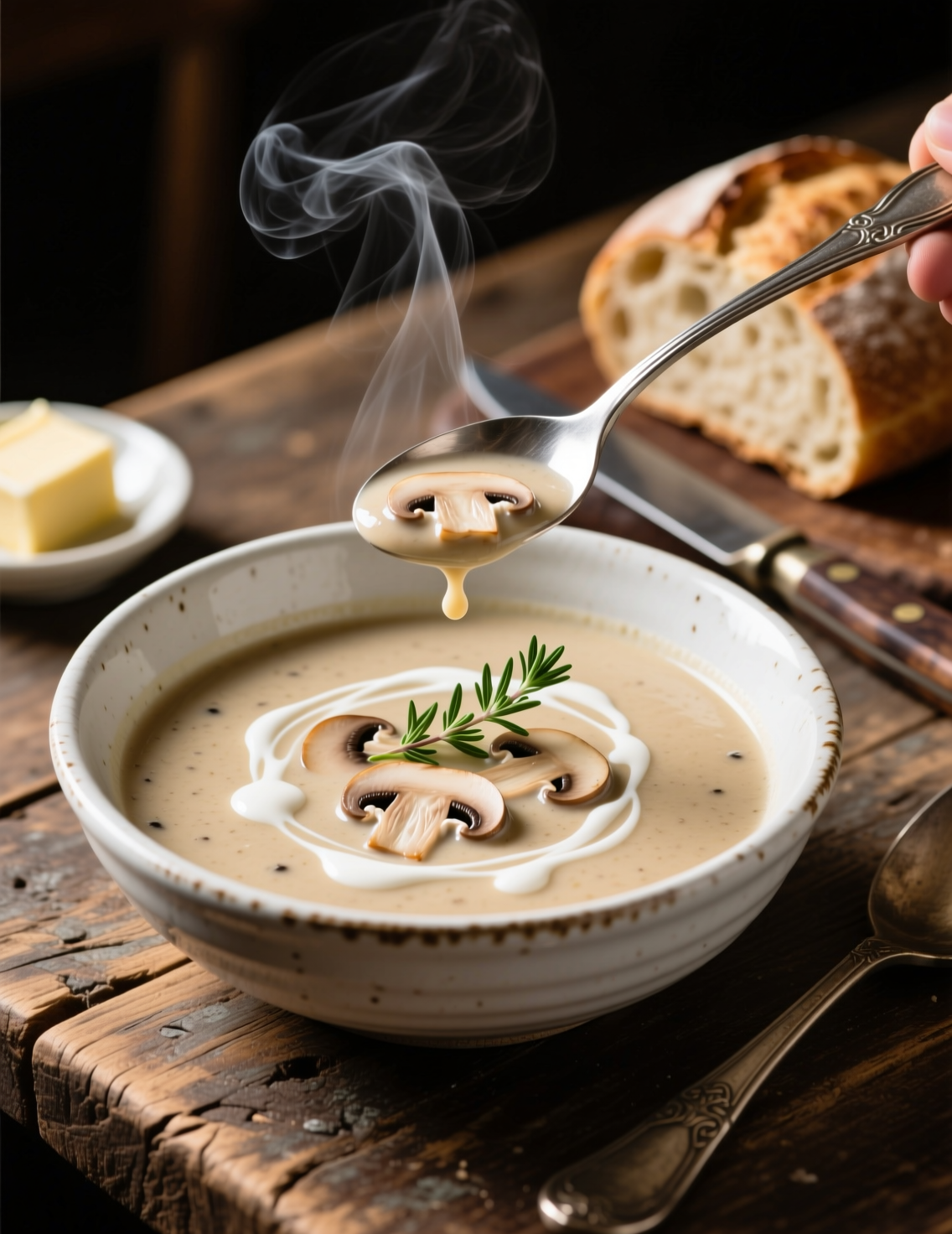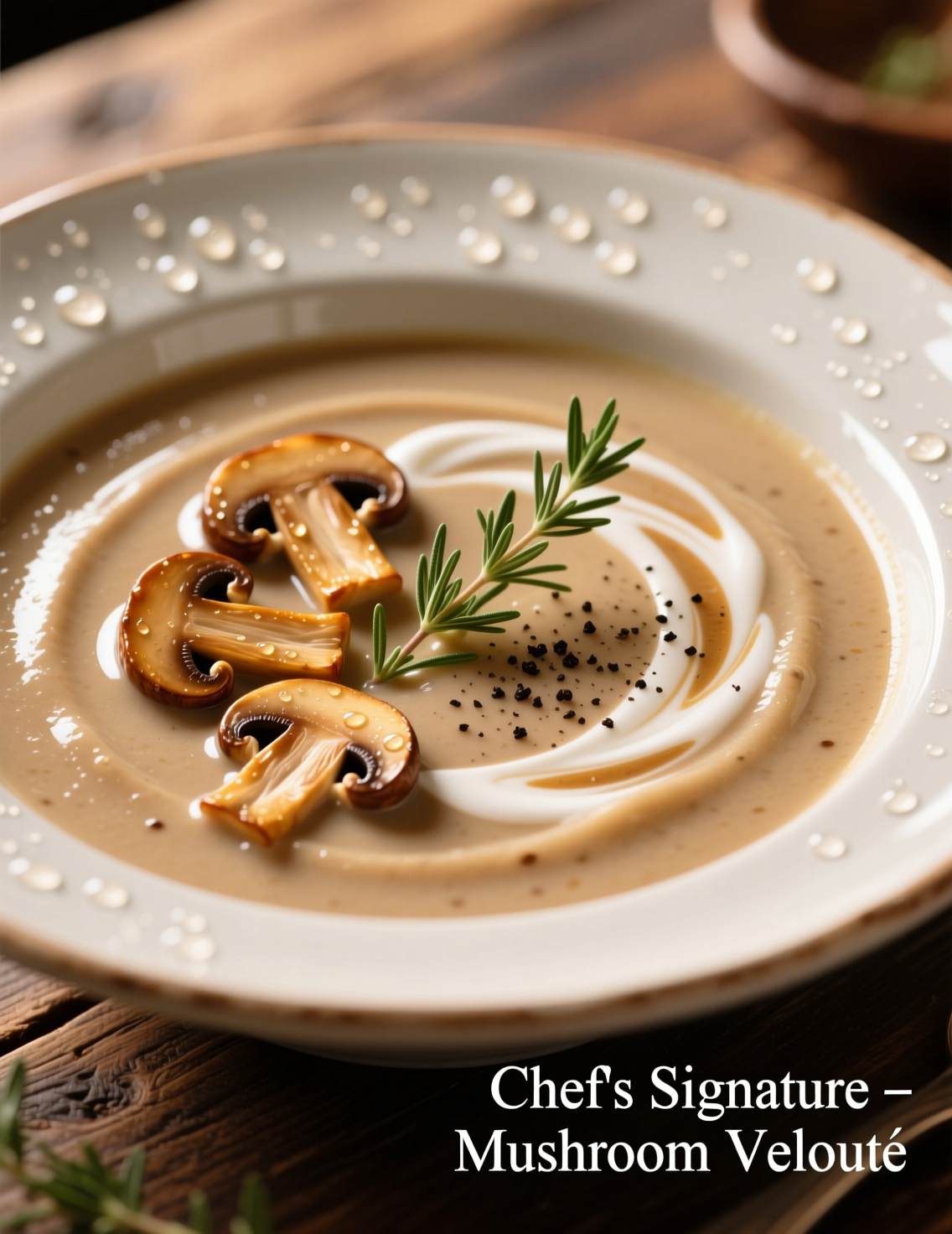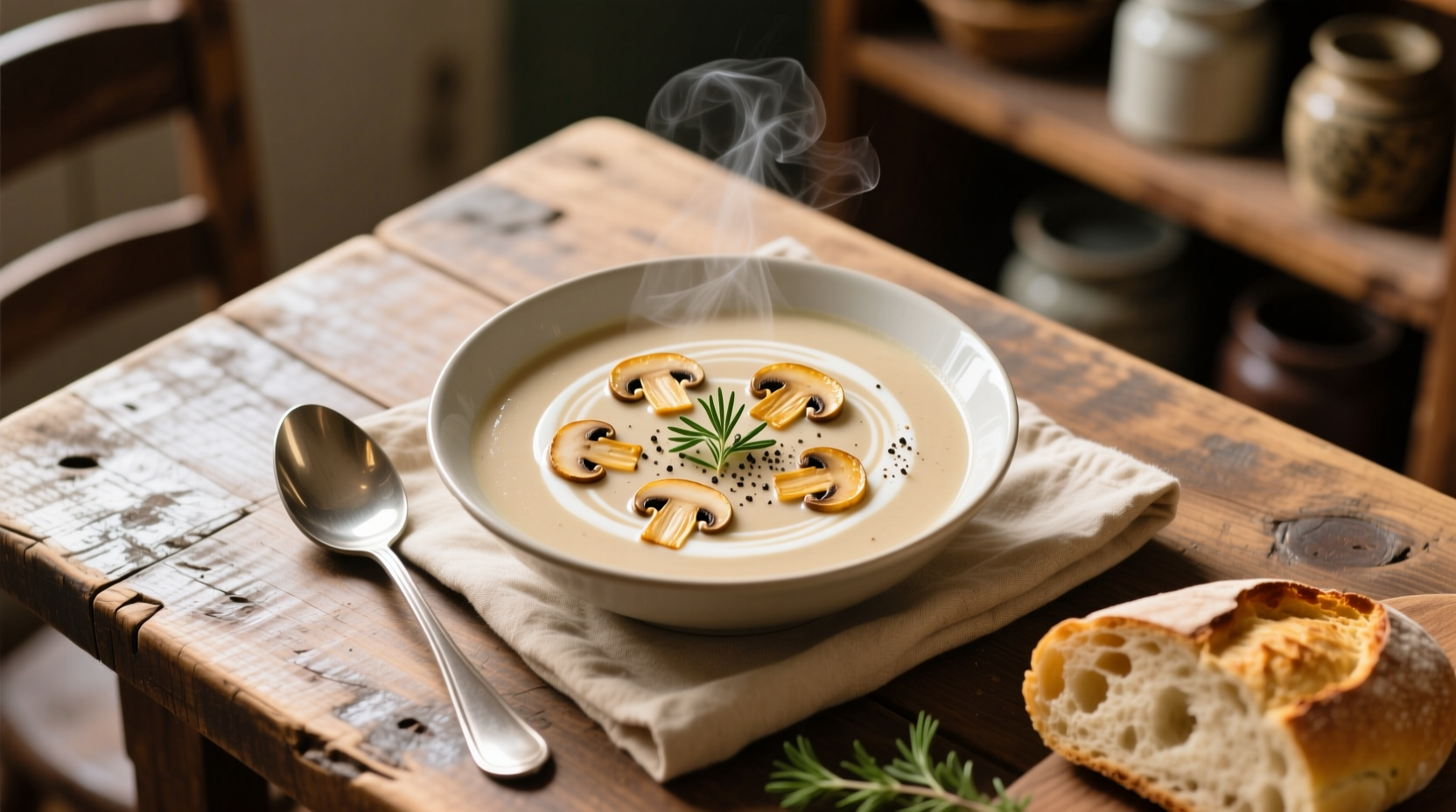Mushroom soup is one of those recipes that looks simple on paper but is anything but ordinary when done right. The question is not whether mushrooms taste good; it’s how far you can push their earthy, umami-rich depth into a bowl of velvety, steaming comfort. The purpose of this article is to take you beyond the basic “cream plus mushrooms” formula and show you the craft, the science, and the chef-level tricks behind a professional Creamy Mushroom Soup that serves 4.
Why Mushroom Soup Is More Complex Than It Appears
Mushrooms are fascinating. They’re not plants, not animals either—fungi carry their own flavor chemistry. Their cell walls are loaded with glutamates, the same compounds that make Parmesan cheese and soy sauce taste addictive. That’s why even a plain mushroom can give a dish layers of savoriness without adding a single pinch of salt.
A creamy mushroom soup, when prepared well, is a masterclass in umami balance. Too much cream, and you mute the mushrooms. Too little, and the soup leans harsh and muddy. The sweet spot is a marriage—cream coats the tongue, while sautéed mushrooms strike with earth and depth. This balance is where most home cooks trip, but professionals know better.
Choosing the Right Mushrooms
This part makes or breaks the recipe. Button mushrooms? Fine for background. Cremini (baby bellas)? A step up, with a nuttier bite. Shiitake? They carry smoke and intensity, but beware—overuse makes the soup overwhelming. Porcini, especially dried, are the ace card. Hydrated in hot water, they release an aroma that instantly elevates broth from flat to complex.
The trick is to combine them. Think of mushrooms like an orchestra. You wouldn’t want only violins. Blend common and specialty mushrooms in roughly 70:30 ratio. That’s enough exotic punch without scaring the palate.
A 2019 study from the Journal of Food Science noted that blending mushrooms with cream-based soups increases perception of “meaty” flavor, even without meat present. That’s real-world data chefs lean on when shaping menus for plant-forward diners.
Preparation Is Half the Flavor
You don’t just toss mushrooms into a pot and expect magic. Mushrooms release a ton of water. If you boil them right away, you lose control of their flavor. The chef’s method: sauté them hard in butter or oil first, preferably in batches. This caramelization—the Maillard reaction—locks in flavor and keeps the soup from tasting watery.
Don’t crowd the pan. Yes, it takes longer, but when mushrooms steam instead of brown, you trade umami for blandness. Many professionals even deglaze with sherry or dry white wine after the sauté. That alcohol burns off but leaves sweetness and complexity clinging to the mushrooms.

Building the Base
The soup begins with aromatics. Onions, shallots, sometimes leeks. They need a slow sweat, not a fry—gentle heat to release sugars without browning too hard. Garlic enters later; too early, and it burns, turning bitter.
The liquid base decides the soup’s backbone. Vegetable stock is light and clean. Chicken stock adds depth and warmth. For professional kitchens, a double stock (a fortified version made by simmering roasted bones and vegetables longer) creates body you can almost chew. If you only have boxed stock, reduce it first to concentrate flavor.
Once mushrooms and aromatics meet stock, simmering should be patient but not excessive. Thirty minutes is usually enough to coax flavors into union. Over-simmering leads to dull, muddy broth.
The Role of Cream and Alternatives
Cream isn’t the enemy—it’s the frame around the painting. Heavy cream coats flavors, makes them linger. But add it too soon, and it risks curdling under long heat. The proper way: finish the soup with cream at the end, off direct boil.
Some chefs swap part of the cream for crème fraîche, which adds a slight tang. Others lean on cashew cream for dairy-free diners, which mimics the silkiness but with a nutty undertone. Plant-based cooking has made this adjustment more common in professional menus.
In 2022, the Good Food Institute reported a 6% rise in demand for plant-based soups in restaurants across the U.S. Mushroom soup, naturally vegetarian, is a perfect candidate for such innovation.
Texture: Pureed vs Rustic
Here’s where opinions split. Some chefs swear by silky-smooth mushroom soup, passed through a fine chinois strainer until it resembles velvet. Others leave chunks of mushroom intact, allowing texture to remind the diner what they’re eating.
The best compromise? A hybrid approach. Puree ¾ of the soup until smooth, then fold in the remaining sautéed mushrooms for chew. That way you get both elegance and rustic charm in one spoonful.
A professional trick: add a small cooked potato during simmering before blending. It thickens naturally, saving you from cornstarch slurries or excess cream.
Garnishes: The Signature on the Canvas
Soup without garnish is unfinished. Professional presentation matters, even at home. Consider drizzling a few drops of truffle oil for aroma, scattering fresh thyme leaves, or topping with a spoonful of whipped cream infused with horseradish.
Toasted sourdough croutons are another classic. They add crunch, salt, and soak up the broth without disintegrating immediately. Some chefs even crisp thin slices of mushroom as chips and float them on top.
One restaurant in Lyon serves creamy mushroom soup tableside with a small quenelle of mascarpone in the center. The cream melts into the broth as you stir. That tiny flourish creates drama that diners remember.
Step-by-Step: Professional Creamy Mushroom Soup (4 Servings)
Ingredients
- 500 g mixed mushrooms (cremini, shiitake, porcini, button)
- 2 tbsp butter
- 1 tbsp olive oil
- 1 medium onion, finely chopped
- 2 cloves garlic, minced
- 750 ml chicken or vegetable stock
- 120 ml heavy cream
- 60 ml dry sherry or white wine
- 1 small potato, peeled and diced (optional, for thickness)
- Fresh thyme, salt, pepper to taste
Method
- Clean mushrooms with a damp cloth, never under running water—they absorb liquid like sponges.
- Slice them thick, then sauté in butter and oil in batches until golden brown. Remove and set aside.
- In same pot, sweat onion gently until translucent. Add garlic last, cooking 30 seconds.
- Deglaze pan with sherry, scraping brown bits.
- Add half mushrooms, potato, and stock. Simmer 25–30 minutes.
- Blend soup until silky. Return to pot.
- Stir in cream and remaining mushrooms. Heat gently, don’t boil.
- Season with salt, cracked pepper, and thyme leaves. Serve hot with garnish of choice.
Common Mistakes Professionals Avoid
- Overwashing mushrooms. They soak water fast and become spongy. Wipe with cloth instead.
- Adding cream too early. Causes curdling and loss of richness.
- Crowding the pan. Steamed mushrooms lack flavor punch.
- Skipping the deglaze. The fond at bottom of pan is liquid gold for flavor.
Nutrition and Practical Insights
One serving of creamy mushroom soup (about 1½ cups) provides roughly:
- Calories: 220
- Protein: 6 g
- Fat: 16 g
- Carbohydrates: 15 g
- Fiber: 3 g
Not exactly diet food, but balanced when paired with lean protein or salad. For lower calories, reduce cream and swap half for milk or unsweetened almond milk. Mushrooms themselves are high in B vitamins and selenium, both critical for energy metabolism and immune function.

Mushroom Soup in Culinary Culture
Mushroom soups aren’t just European classics. In Japan, miso-mushroom broths form a bridge between savory and earthy. In Eastern Europe, wild mushroom soups dominate fall and winter tables, often with sour cream stirred in. French cuisine prizes velouté de champignons, smooth as silk, often presented as a starter before game meats.
This global presence shows why mushroom soup isn’t “just a starter.” It’s a dish with historical backbone, cultural variation, and professional respect.
Trends: Where Mushroom Soup Is Headed
Plant-based dining has shifted the narrative. Mushroom soups are increasingly crafted without dairy, instead using oat cream, cashews, or even coconut milk. Fine-dining chefs experiment with mushroom cappuccinos—foamed mushroom broth in espresso cups as amuse-bouches. Street food vendors, meanwhile, enrich soups with chili oil and sesame, blending East and West.
Chefs also embrace wild and foraged mushrooms more than ever. Chanterelles, morels, hen of the woods—they cost more, but add rare aroma. Diners crave novelty, and mushrooms deliver.
Conclusion: Why This Soup Matters
Creamy mushroom soup may look like humble comfort food, but professionals know it’s a dish of detail and patience. The way you choose mushrooms, caramelize, balance cream, and garnish defines whether your bowl is forgettable or unforgettable.
Takeaways? Don’t drown mushrooms in cream—let them shine. Mix varieties for depth. Treat the base stock like liquid architecture. And always finish with something that excites the eye as much as the palate.
Mastering this recipe for 4 servings isn’t just about feeding people. It’s about respecting ingredients, balancing science and art, and delivering warmth that lingers long after the last spoonful. That, really, is the mark of a true chef.
FAQs
What type of mushrooms are best for creamy mushroom soup?
A mix of common and specialty mushrooms like cremini, shiitake, and porcini gives the best depth.
Can I make this soup without cream?
Yes, you can use cashew cream, oat cream, or even coconut milk for a dairy-free option.
Why should I sauté mushrooms before simmering?
Sautéing caramelizes and concentrates flavor, preventing a watery, bland soup.
How do I prevent cream from curdling in the soup?
Always add cream at the end on low heat, never during a rolling boil.
Is it okay to wash mushrooms under water?
No, just wipe with a damp cloth because mushrooms absorb water and lose flavor.
Can I prepare mushroom soup in advance?
Yes, but add cream only when reheating to keep the texture silky.
What stock works best for mushroom soup?
Chicken stock adds warmth, while vegetable stock keeps it light and vegetarian.
Should mushroom soup be blended smooth or left chunky?
It depends—some prefer it silky, others enjoy rustic pieces, so do a mix of both.
How can I thicken mushroom soup naturally?
Adding a diced potato during simmering gives body without flour or cornstarch.
What garnishes pair well with creamy mushroom soup?
Fresh herbs, truffle oil, toasted croutons, or crisp mushroom chips make excellent toppings.

Mariana is a passionate home cook who creates delicious, easy-to-follow recipes for busy people. From energizing breakfasts to satisfying dinners and indulgent desserts, her dishes are designed to fuel both your body and hustle.
When she’s not in the kitchen, she’s exploring new flavors and dreaming up her next recipe to share with the Foodie Hustle community.

